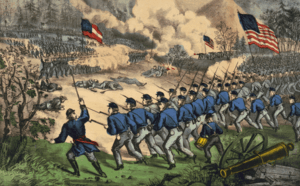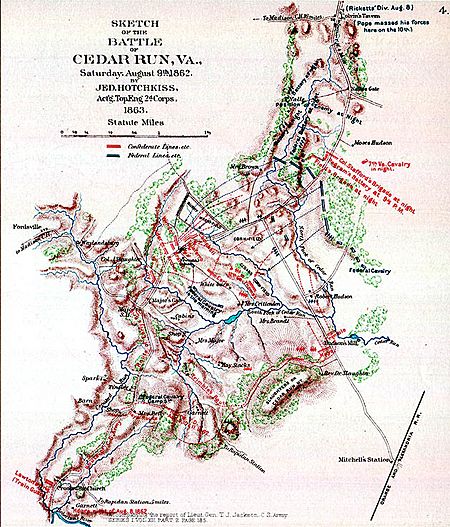Battle of Cedar Mountain facts for kids
Quick facts for kids Battle of Cedar Mountain(Battle of Slaughter's Mountain) |
|||||||
|---|---|---|---|---|---|---|---|
| Part of the American Civil War | |||||||
 The battle at Cedar Mountain, by Currier and Ives |
|||||||
|
|||||||
| Belligerents | |||||||
| Commanders and leaders | |||||||
| Nathaniel P. Banks | Stonewall Jackson | ||||||
| Units involved | |||||||
| Army of Virginia | Army of Northern Virginia | ||||||
| Strength | |||||||
| 8,030 | 16,868 | ||||||
| Casualties and losses | |||||||
| 2,353 total: 314 killed 1,445 wounded 594 missing |
1,338 total: 231 killed 1,107 wounded |
||||||
The Battle of Cedar Mountain, also known as Slaughter's Mountain, happened on August 9, 1862. It took place in Culpeper County, Virginia, during the American Civil War. Union forces, led by Major General Nathaniel P. Banks, attacked Confederate soldiers. The Confederates were led by Major General Thomas J. "Stonewall" Jackson.
The battle happened near Cedar Mountain. Confederates were marching towards Culpeper Court House. They wanted to stop the Union army from moving deeper into central Virginia. At first, the Union army almost won. But a strong Confederate counterattack pushed the Union soldiers back. This led to a Confederate victory. This battle was the first major fight of the Northern Virginia campaign.
Contents
Why the Battle Happened
On June 26, 1862, Major General John Pope took charge of the new Union Army of Virginia. Pope spread his army out across Northern Virginia. One part of his army, led by Major General Nathaniel P. Banks, was near Little Washington. Another part was at Culpeper Court House.
The Confederate General Robert E. Lee reacted to Pope's moves. He sent Major General Stonewall Jackson and 14,000 men to Gordonsville. Jackson later got 10,000 more soldiers. On August 6, Pope moved his army south into Culpeper County. His goal was to capture the important rail junction at Gordonsville. He hoped this would distract the Confederates.
Jackson decided to attack first. He wanted to strike Pope's lead forces under Banks. He hoped to defeat them before Pope's entire army could gather. After beating Banks, Jackson planned to move on Culpeper Court House. This would stop Pope's army from joining up. Jackson wanted to fight and defeat each Union group separately. He had done this successfully in his Valley Campaign.
Jackson started his march towards Culpeper on August 7. His cavalry, led by Brigadier General Beverly Robertson, went ahead. They easily cleared out Union cavalry guarding the rivers.
Challenges on the March
Jackson's march was slowed down by very hot weather. Also, Jackson kept his plans secret, which confused his commanders. Because of this, his army only moved about 8 miles by the evening of August 8. The Union cavalry, even though they were pushed back, quickly told Pope about the Confederate advance.
Pope then ordered another Union general, Sigel, to reinforce Banks at Culpeper Court House. Banks was told to hold a strong defensive line. This line was on a ridge above Cedar Run, about 7 miles south of Culpeper Court House.
The Battle Begins
Confederate Setup
On the morning of August 9, Jackson's army crossed the Rapidan River. They moved into Culpeper County. Major General Richard S. Ewell's division led the way. They were followed by Brigadier General Charles S. Winder's division. Major General A.P. Hill's division was at the back.
Just before noon, Brigadier General Jubal Early's brigade, the first part of Ewell's division, met Union cavalry and artillery. These Union forces were on a ridge above Cedar Run. Early brought up his cannons, and an artillery fight started. Early's soldiers then formed a line on the east side of the main road. This was on high ground across Cedar Run.
As more of Ewell's division arrived, they formed on Early's right. They were positioned against the northern slope of Cedar Mountain. Winder's division formed on Early's left, on the west side of the road. Winder's cannons filled a gap between the two divisions. The famous Stonewall Brigade was placed behind the cannons for support. A.P. Hill's division, still marching, was ordered to wait in reserve on the Confederate left.
Union Setup
The Union soldiers formed a line on a ridge above Cedar Run. Brigadier General Samuel W. Crawford's brigade was on the Union right. Brigadier General Christopher C. Augur's division was on the Union left, east of the main road. Brigadier General John W. Geary's brigade was on the road, facing the Confederates. Brigadier General Henry Prince's brigade was on the far left. Brigadier General George S. Greene's smaller brigade was kept in reserve.
The Fight Unfolds
Union Attacks
A little before 5:00 p.m., the cannon fight started to slow down. Confederate Brigadier General Charles S. Winder was badly wounded. He had been sick that day and was in an ambulance. A shell fragment hit him while he was trying to lead his troops. Winder died a few hours later. Command of his division went to William Taliaferro. He did not know Jackson's battle plan.
The Union attack began before the Confederates could fully get organized. Geary and Prince attacked the Confederate right. The Union advance was fast and almost broke the Confederate line. General Early quickly rode to the front to help. Early's presence and heavy Confederate cannon fire stopped the Union advance on the right.
On the left, Crawford attacked Winder's division. He sent three of his regiments across a wheat field. Six companies of the 3rd Wisconsin also advanced through a bushy field. Crawford's attack quickly crossed the wheat field. The Confederates were busy fighting elsewhere. The Union soldiers crashed into the woods. They hit the side of the 1st Virginia Infantry Battalion, who then ran away.
The Union soldiers kept pushing, not stopping to regroup. They rolled through the 42nd Virginia. Soon, they were behind Taliaferro's troops and the cannons. Just as Crawford's attack started, the Stonewall Brigade moved up. They formed a line along the southern end of the bushy field. But there was still a gap between them and another Confederate brigade. Crawford's men poured through this gap.
Taliaferro sent the 10th Virginia to help. But they also had to retreat quickly. The Stonewall Brigade attacked the 3rd Wisconsin, routing them in minutes. But then the Stonewall Brigade learned that part of their own line had run away. Jackson ordered the cannons to be moved before they could be captured. The Union attack hit Taliaferro and Early's left very hard.
Confederate Counterattack
At this critical moment, General Jackson rode to that part of the field. He wanted to rally his men. He found soldiers from the 27th Virginia, part of his old brigade. Jackson tried to pull out his sword to inspire them. But he rarely used it, and it was stuck in its scabbard.
Not giving up, he unbuckled his sword and waved it, scabbard and all, over his head. He then grabbed a battle flag from a soldier who was retreating. He yelled at his men to rally around him. The rallied troops joined with fresh soldiers from A.P. Hill's division. They stopped Crawford's advance.
Meanwhile, the Stonewall Brigade turned to their right. They moved into the western end of the wheat field. This put them behind Crawford's men. Crawford's soldiers were now being attacked from the front by new Confederate troops. With the Stonewall Brigade about to cut them off, Crawford's men began to run back through the wheat field.
The 5th Virginia advanced and captured many Union soldiers. They also took three Union battle flags. One Union captain said it was like walking into a "fiery furnace." Crawford ordered his last reserve regiment, the 10th Maine, to hold the Confederates back. This allowed the rest of his brigade to retreat. The 461-man regiment lost 179 men in a very short fight.
With the Union right side falling apart, Gordon was ordered to advance his brigade. They included the reformed 3rd Wisconsin soldiers. Gordon's three regiments held their position against attacks. But fresh Confederate troops were moving around Gordon's right side.
Suddenly, parts of the Stonewall Brigade and another brigade attacked the side of the 27th Indiana. One Indiana soldier remembered a "withering volley" of fire. The Confederates then charged with bayonets. Gordon's line quickly collapsed, and his men ran away. Jackson also ordered Ewell to advance. Ewell was delayed, but the Union left began to waver. A charge down Cedar Mountain by Brigadier General Isaac R. Trimble's brigade finally broke them.
Confederate Chase
By 7:45 p.m., the Union line was fully retreating. To help his infantry escape, Banks sent two cavalry groups at the Confederate line. They were met with heavy fire from Confederate soldiers behind a fence. Only 71 out of 174 cavalrymen escaped.
The Confederate infantry and cavalry chased the retreating Union soldiers. They almost captured Banks and Pope, who were at their headquarters. After chasing for about a mile and a half, Jackson became cautious as darkness fell. He wasn't sure where the rest of Pope's army was.
Union soldiers captured by the Confederates told them that Pope was bringing more troops forward. So, Jackson called off the chase. By around 10:00 p.m., the fighting stopped. By this time, more Union troops had arrived. They helped cover Banks's retreat.
What Happened After
The battle had many casualties. The Union army lost 2,353 soldiers. This included 314 killed, 1,445 wounded, and 594 missing. The Confederates lost 1,338 soldiers, with 231 killed and 1,107 wounded. Crawford's brigade lost more than half of its soldiers. Both Union generals, Prince and Geary, were wounded. Prince was also captured. Confederate Brigadier General Winder was mortally wounded.
For two days, Jackson stayed south of Cedar Run. He waited for a Union attack that never came. On August 12, Jackson learned that all of Pope's army had arrived at Culpeper Court House. So, Jackson moved back to a stronger defensive position behind the Rapidan River.
Jackson was almost defeated because of the weather and poor communication. He expected to face a cautious enemy, but Banks attacked boldly. However, excellent leadership by the Confederates at key moments saved the day. The arrival of A.P. Hill's troops also helped. Their larger numbers eventually drove the Union forces away.
Banks, who had been defeated by Jackson before, wanted to win this time. Instead of fighting defensively, he attacked Jackson even though he was outnumbered two to one. This bold move almost worked, but he was defeated by Jackson again.
Because Jackson was causing so much trouble, General-in-Chief Henry W. Halleck became worried. He stopped Pope's advance on Gordonsville. This gave Lee the advantage in the Northern Virginia campaign. The battle moved the fighting in Virginia from the Virginia Peninsula to northern Virginia.
Saving the Battlefield
The American Battlefield Trust and its partners have worked to save parts of the battlefield. By late 2021, they had preserved 584 acres (236 hectares).
Most of the saved land is near the intersection of Virginia State Routes 15 and 657. This area includes where Crittenden Gate once stood. It also includes the wheat field where some of the bloodiest fighting happened. The Trust saved 152 acres (61.5 hectares) there in 1998. They added more land in 2010 and 2013. A local group, the Friends of Cedar Mountain Battlefield, helped a lot with these efforts.
The 10 acres (4 hectares) saved in 2012 are close to the Crittenden Gate site. This land includes where General Winder was mortally wounded. It also has the locations of Jackson's command post. This is also where Jackson made his desperate effort to rally Confederate troops during the battle.
See also
 In Spanish: Batalla de Cedar Mountain para niños
In Spanish: Batalla de Cedar Mountain para niños




